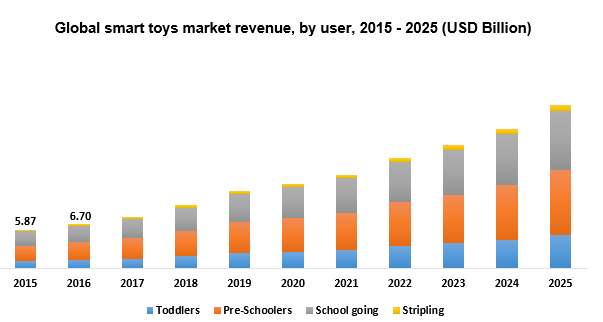
Smart Toys Market Size and Forecast, By User (Toddlers, Pre-schoolers, School-going, Stripling), By Distribution Channel (Convenience Stores, Specialty Stores, Online Channel) and Trend Analysis, 2019 - 2025
- Published: February, 2019
- Format: Electronic (PDF)
- Number of pages: 65
- Industry: Electronic Devices
Industry Insights
The global smart toys market was valued at USD 7.78 billion in 2017 and is expected to grow at a CAGR of 15.5% from 2017 to 2025. The gaining popularity of smart toys as an effective medium for developing the mental, physical and intellectual skills of children through the utilization of artificial intelligence is expected to have a positive impact on the market. These products act as interactive toys which engage the users, particularly, children into some course of action and challenge them to think, feel and react accordingly.

Over the past few years, the education value associated with these toys has spurred key industry participants to introduce variants with more advanced voice recognition features and hardware sensors which make the product more intelligent, interactive and dynamic.
Segmentation by User
• Toddlers
• Pre-Schoolers
• School Going
• Stripling
The global smart toys market revenue from pre-schoolers segment was USD 3.07 billion in 2017 and is expected to grow at a CAGR of more than 15.5% from 2017 to 2025. The growth is attributed to the strong demand from the 3-5 years age group on a global level. In the U.S., which is a key market, around 27.0% of the population aged below 18 years constituted of 0-4 years age group. The rising concern about kids spending more time on digital devices is expected to promote the utility of smart toys as an alternative in the coming years. Moreover, the emergence of new smart toys with artificial intelligence enabled features to assist in strengthening the creative mind, particularly in pre-schoolers.
The market for toddler segment is expected to grow at a CAGR of more than 16.3% from 2017 to 2025. The gaining acceptance of smart toys as a media that responds to toddlers speech is expected to have a positive impact on the demand. For instance, Hello Barbie is AI-driven doll that uses voice recognition and cloud computing technologies and holds a conversation with kids.
School going segment accounted for more than 36.5% share of the market in 2017. Increasing spending on the development of toys which are based on the principle of STEM (Science, Technology, Engineering, and Maths) is expected in the near future. These toys enable children to grasp subject-based knowledge in order to broaden their thinking ability related to a specific subject from an early age.
Segmentation by Distribution
• Convenience stores
• Specialty stores
• Online channel
Specialty stores are the prominent distribution channel and command a major share of the market. These stores accounted for well over 40.0% of the market share in 2017 and are expected to grow further over the forecast period. Stores by companies such as Mattel and Hamleys in key countries such as the U.S. is expected to remain a favourable factor.
Online sales channel, on the other hand, is expected to grow at a CAGR of well over 16.0% from the period of 2017 to 2025. In recent years, smart toy manufacturers have increased spending on strengthening their online presence. The increasing adoption of e-commerce portals as a key sales channel is expected to strengthen further in the coming years.
Segmentation by Region
• North America
• U.S.
• Europe
• UK
• Asia Pacific
• China
• India
• Middle East & Africa
• Central & South America
• Brazil
In North America, the demand for smart toys is expected to surpass USD 9.80 billion mark by the end of 2025. Increasing adoption of these toys among toddlers and pre-schoolers in the U.S. and Canada on account of strong product awareness through e-commerce portals and print and digital media is expected to remain a favourable factor over the coming years.
The Asia Pacific region is expected to foresee revenue growth at a CAGR of more than 18.0% from 2017 to 2025. The shifting trend in emerging economies such as China and India towards digital learning is expected to spur growth in the smart toys market. Moreover, the presence of various R&D facilities of artificial intelligence firms operating in countries such as Japan and South Korea is expected to move smart toy manufacturers to establish partnerships to advance their products and gain competitive advantage.
Competitive Landscape
Smart toy manufacturing firms are focussing on product innovation to expand their product portfolio. In the coming years, companies are expected to expand their presence to key growth markets in the Asia Pacific region. Companies will also focus on leveraging e-commerce portals to extend their visibility and gain more consumers. Some of the key manufacturers in the market include Dream International, Jakks Pacific, Inc., Hasbro Inc., Makeblock Co., Ltd., The Lego Group, Mattel Inc., KNEX Industries Inc., UBTECH Robotics, Inc., Konami, Kids II, Inc., and Playmobil.

Choose License Type
- World's largest premium report database
- Transparent pre & post sale customer engagement model
- Unparalleled flexibility in terms of rendering services
- Safe & secure web experience
- 24*5 Research support service
